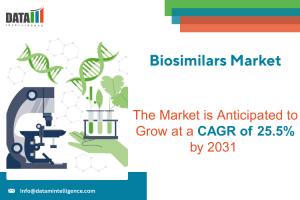Biosimilars Market Anticipated to Grow at a CAGR of 25.5% During 2025-2033 | DataM Intelligence
Biosimilars market Projected to reach USD 171.79 bn in 2033, driven by demand for cost-effective biologics, with strong growth projected in the coming years.
Market Overview:
Biosimilars are biologic medical products that are highly similar to an already approved reference biologic in terms of safety, efficacy, and quality, yet typically offered at a lower price point. As patent protections for blockbuster biologics such as monoclonal antibodies and recombinant proteins expire, biosimilars offer a cost-effective alternative that can expand patient access and alleviate healthcare budgets. Analysts project the global biosimilars market to reach USD 171.79 billion by 2033, growing at a compound annual growth rate (CAGR) of 25.5% During 2025-2033.
Market Drivers:
• Patent Expirations of Key Biologics
A wave of patent cliffs for top-selling biologics is creating significant opportunities for biosimilar entrants.
• Rising Biologic Treatment Demand
An aging population and greater prevalence of chronic diseases such as cancer and autoimmune disorders fuel the need for biologic therapies.
• Cost-Containment Pressures on Healthcare Systems
Budget constraints and policy mandates are driving payers and hospitals to adopt lower-cost biosimilars.
• Regulatory Harmonization and Streamlined Approvals
Agencies like the FDA and EMA have established clear biosimilar pathways, reducing time to market.
• Physician and Patient Acceptance
Growing real-world evidence and education initiatives are increasing trust in biosimilar safety and efficacy.
Get Detailed Premium Sample PDF: https://www.datamintelligence.com/download-sample/biosimilars-market
Market Segments
By Product Type
• Monoclonal Antibodies
• Recombinant Human Growth Hormone (rhGH)
• Insulin
• Anti-coagulants
• Erythropoietin
• Granulocyte Colony Stimulating Factor
• Follitropin
• Interferons
• Others
By Indication
• Oncology
• Chronic Diseases
• Autoimmune Diseases
• Infectious Diseases
• Growth Hormone Deficiency
• Hematology
• Others
Geographical Analysis: Production and Consumer Trends in North America
The biosimilars industry is primarily dominated by North America due to the pervasive use of biologics and the development of increasingly sophisticated regulatory frameworks. To date, the United States has authorized more than 35 biosimilars, and Medicare and Medicaid have encouraged their use through reimbursement schemes. The Canadian biosimilar environment is changing in response to provincial switching regulations that promote cost-effective remedies. Innovative manufacturing skills are essential for the maintenance of consistent batch quality and supply security at production centers in the United States and Canada. Nevertheless, health systems and payers are motivated to pursue formulary modifications and procurement procedures that prioritize biosimilars due to the fact that patient savings can exceed 30% when compared to reference biologics.
Pricing Analysis:
Biosimilar pricing is subject to variation based on the molecule and market, but the average reduction is between 15% and 40% of the retail price of the original biologic. The initial biosimilar releases of filgrastim and infliximab in the United States led to an average reduction of 30% in costs. However, subsequent entrants further reduced costs, resulting in savings of up to 40%. Canadian provincial proposals have experienced price reductions of 25 to 35 percent in competitive auctions. As additional biosimilars enter the market, price competition is anticipated to intensify, potentially resulting in a 40% or greater decrease in net prices over the next five years.
Pipeline Analysis:
North America and Europe account for more than 60% of all late-stage biosimilar activity on a regional scale, suggesting that there are established regulatory channels and economic incentives. Asia-Pacific, particularly India and South Korea, are expanding their capacity by over 20% with pipeline candidates, utilizing cost-effective manufacturing to target both domestic and export markets. The wave of approvals will significantly expand the biosimilars landscape, intensify competition, and deepen price pressures as these candidates progress through comparative pharmacokinetic, immunogenicity, and efficacy studies. Ultimately, this will improve patient access to critical biologic therapies.
Sustainability Analysis:
In addition to reducing direct medication costs, biosimilars also contribute to the sustainability of healthcare by reducing the cost of disease-related complications. Through 2025, the United States may reinvest over $100 billion in incremental savings in innovation, patient assistance programs, and expanded coverage. Environmentally, biosimilar production capitalizes on existing biologic facilities, thereby reducing the need for new plant construction and reducing the carbon footprint of each treatment cycle.
Recent Mergers & Developments:
• In March 2025, Celltrion announced the U.S. launch of STEQEYMA (ustekinumab-stba), a biosimilar to STELARA (ustekinumab), following approval by the U.S. Food and Drug Administration (FDA) in December 2024.
• In January 2025 Biocon Biologics formed a joint venture with Samsung Bioepis to scale production of high-purity recombinant proteins for global markets.
• In September 2024 Pfizer and BioNTech announced a collaboration to develop interchangeable biosimilars for next-generation oncology targets.
• In March 2024 Amgen completed its acquisition of ChemoTech Biosciences, boosting its monoclonal antibody biosimilar pipeline.
Key Market Players:
• Pfizer Inc.
• Sandoz Group AG
• Teva Pharmaceuticals USA, Inc.
• Biogen
• Amgen Inc.
• Biocon Biologics Inc.
• Boehringer Ingelheim International GmbH
• Fresenius Kabi AG
• Samsung Bioepis
• Dr. Reddy’s Laboratories Ltd.
Full Report Required? Get it Here: https://www.datamintelligence.com/buy-now-page?report=biosimilars-market
Related Reports:
Occupational Medicines Market Scope 2024-2031
Biopharmaceuticals Market Scope 2024-2031
Sai Kumar
DataM Intelligence 4market Research LLP
+1 877-441-4866
sai.k@datamintelligence.com
Visit us on social media:
LinkedIn
X
Legal Disclaimer:
EIN Presswire provides this news content "as is" without warranty of any kind. We do not accept any responsibility or liability for the accuracy, content, images, videos, licenses, completeness, legality, or reliability of the information contained in this article. If you have any complaints or copyright issues related to this article, kindly contact the author above.
Micro Drone Market Growth Insights and Statistical Analysis to show Expanding Industry Size
Morepen Laboratories Limited Expands to UAE: Step-Down Subsidiary in Dubai Mainland Support from Start Any Business
Upcycled Micro-Machines Go Global: Mecrob® Debuts as W.A.Y Studio’s New Art Brand
Więcej ważnych informacji
 Jedynka Newserii
Jedynka Newserii

 Jedynka Newserii
Jedynka Newserii

Polityka

D. Joński: Nie wiemy, co zrobi Rosja za dwa–trzy lata. Według duńskiego wywiadu może zaatakować kraje nadbałtyckie i musimy być na to gotowi
Zdecydowana większość krajów unijnych wskazuje na potrzebę wzmocnienia zdolności obronnych Europy w obliczu coraz bardziej złożonego geopolitycznego tła. Wywiady zachodnich państw wskazują, że Rosja może rozpocząć konfrontację z NATO jeszcze przed 2030 rokiem. Biała księga w sprawie obronności europejskiej „Gotowość 2030” zakłada m.in. ochronę granic lądowych, powietrznych i morskich UE, a sztandarowym projektem ma być Tarcza Wschód. – W budzeniu Europy duże zasługi ma polska prezydencja – ocenia europoseł Dariusz Joński.
Transport
Duże magazyny energii przyspieszą rozwój transportu niskoemisyjnego w Europie. Przyszłością może być wodór służący jako paliwo i nośnik energii

Zmiany w europejskim transporcie przyspieszają. Trendem jest elektromobilność, zwłaszcza w ramach logistyki „ostatniej mili”. Jednocześnie jednak udział samochodów w pełni elektrycznych w polskich firmach spadł z 18 do 12 proc., co wpisuje się w szerszy europejski trend spowolnienia elektromobilności. Główne bariery to ograniczona liczba publicznych stacji ładowania, wysoka cena pojazdów i brak dostępu do odpowiedniej infrastruktury. – Potrzebne są odpowiednio duże magazyny taniej energii. Przyszłością przede wszystkim jest wodór – ocenia Andrzej Gemra z Renault Group.
Infrastruktura
W Polsce w obiektach zabytkowych wciąż brakuje nowoczesnych rozwiązań przeciwpożarowych. Potrzebna jest większa elastyczność w stosowaniu przepisów

Pogodzenie interesów konserwatorów, projektantów, inwestorów, rzeczoznawców i służby ochrony pożarowej stanowi jedno z największych wyzwań w zakresie ochrony przeciwpożarowej obiektów konserwatorskich. Pożary zabytków takich jak m.in. katedra Notre-Dame w Paryżu przyczyniają się do wprowadzania nowatorskich rozwiązań technicznych w zakresie ochrony przeciwpożarowej. W Polsce obowiązuje już konieczność instalacji systemów detekcji. Inwestorzy często jednak rezygnują z realizacji projektów dotyczących obiektów zabytkowych z uwagi na zmieniające się i coraz bardziej restrykcyjne przepisy czy też względy ekonomiczne.
Partner serwisu
Szkolenia

Akademia Newserii
Akademia Newserii to projekt, w ramach którego najlepsi polscy dziennikarze biznesowi, giełdowi oraz lifestylowi, a także szkoleniowcy z wieloletnim doświadczeniem dzielą się swoją wiedzą nt. pracy z mediami.




![Nestlé w Polsce podsumowuje wpływ na krajową gospodarkę. Firma wygenerowała 0,6 proc. polskiego PKB [DEPESZA]](https://www.newseria.pl/files/1097841585/fabryka-nesquik_1,w_85,r_png,_small.png)




.gif)

 |
| |
| |
|